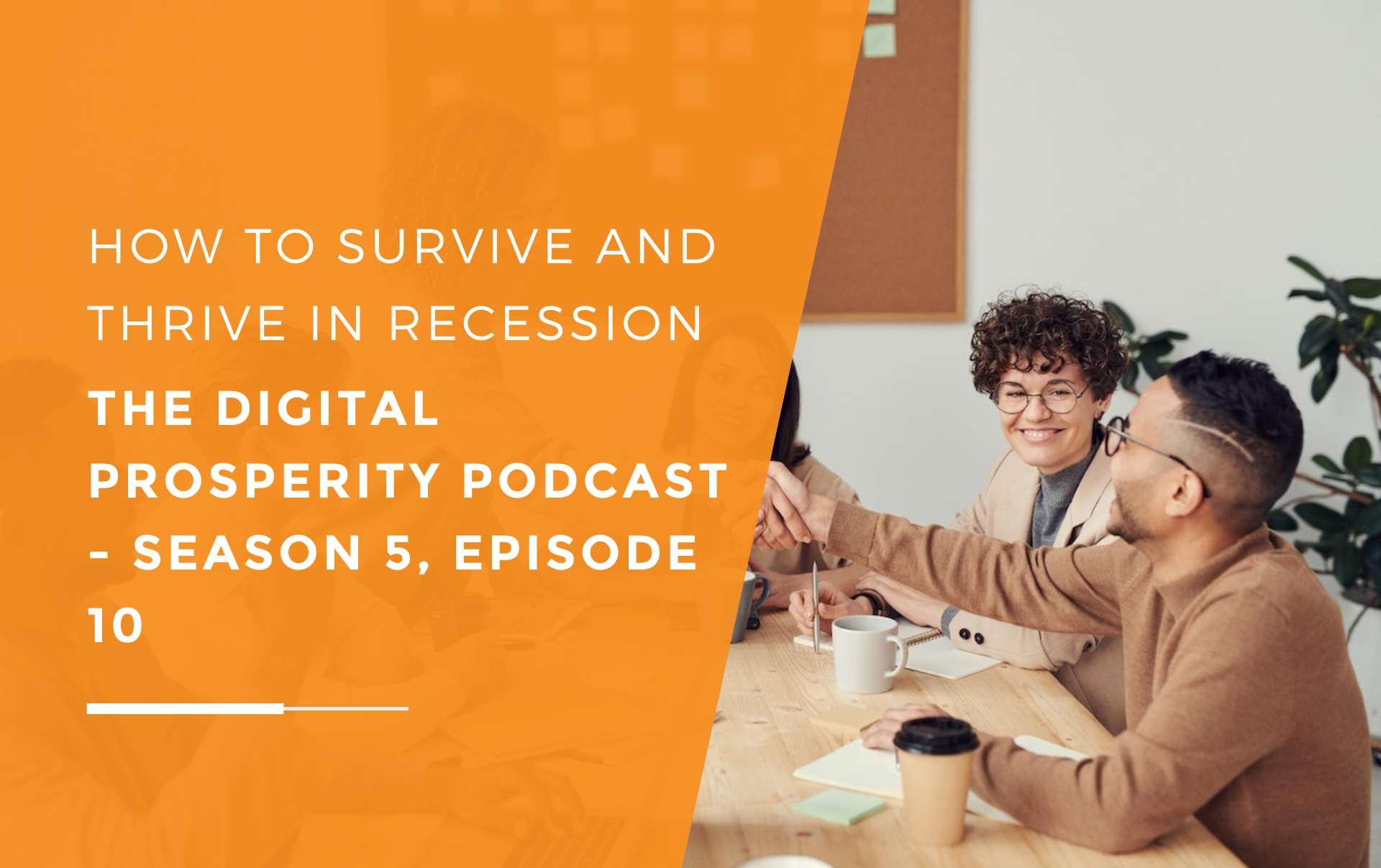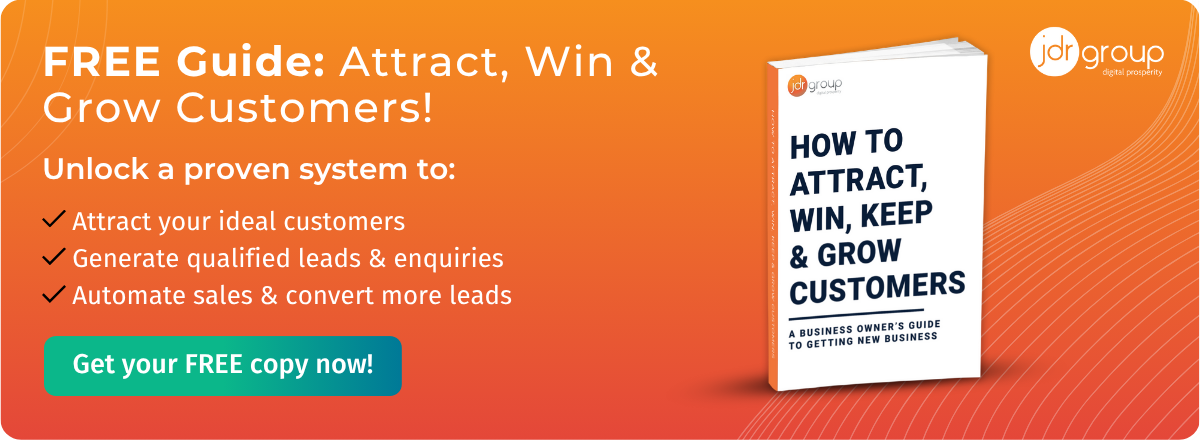6 Steps To Growing Through The Recession - The Digital Prosperity Podcast - Season 5, Episode 9
by Shirley Gibbins on 13-Feb-2023 13:00:00

Recession is something that no person or organisation wants to experience again, but with the cost of living crisis, supply chain issues and high inflation, another recession seems inevitable. However, it doesn’t mean that businesses should be affected negatively. In fact, at JDR Group, we believe that a recession can still help businesses grow through their digital marketing if managed correctly.
That’s why in this episode of the Digital Prosperity Podcast, our directors Will Williamson and David Roberts discussed the six-step system that businesses should adopt to help them grow through the recession.
Step 1: Have A Marketing Strategy In Place
The first step that Will and David discuss is the foundations needed for an effective marketing strategy. This is more than looking at what your competitors are doing, as it also involves thinking about what strategies to consider to attract your customer to your products or services through your website.
With the strategy in place, you can then start to look at what tools and systems you can implement to meet your objectives and get the best results possible across your digital marketing channels.
If you’re unsure about how to go about your marketing strategy, we have a free e-book called ‘How To Create A Marketing Plan’ which includes a strategy checklist you can download.
Step 2: Create Consistent, Interesting Content
Once you have established your strategy, you'll need to start producing consistent, interesting and useful content across your website. As Will mentions in the podcast this can be blog articles, videos, podcasts or any format that you feel will appeal most to your ideal customer. Producing regular content saves the need to pay for advertising as your website is more likely to be found organically through relevant keywords and SEO.
During the podcast, Will and Dave both highlighted just how important it is to produce regular content because it can then be an asset to your business. Not only will that create more visits and leads, but also change the way your business is viewed within your industry as you become a more credible and trusted source for new and existing customers.
Step 3: Drive More Website Traffic
So you’ve created your strategy and are producing regular content to appeal to your ideal customer. This will increase traffic on your website and the likelihood of enquiries, but there are ways that this can be accelerated, such as:
- SEO
- Facebook Ads
- Google Ads
- LinkedIn Ads
- Social media promotion
- Email marketing
By looking at other methods of showcasing your content across various platforms, your website traffic will vastly increase which brings more visitors. This can be applied across different marketing strategies and managed effectively using a CRM system such as Hubspot that allows you to manage and coordinate the activities within your strategy.
Step 4: Conversion Optimisation
So, your website traffic is growing because of your effective strategy and regular content, which means you now need to convert those visitors into leads.
Conversion optimisation is a tried and tested process that increases the likelihood of website users going deeper into your website to find the solution to their problems. Effective conversion optimisation methods include CTA’s (calls to action) on blog posts, lead flows, optimising high-performing blog posts and much more.
Step 5: Follow up On Leads
For the penultimate step of this system, it’s time to make sure that you follow up on those leads generated from the website. These leads are gathered on your CRM system, so now you can explore the possibility of automation to nurture these leads and ensure they remain interested.
As Will mentions in the episode, you can help educate them towards making that final decision with case studies, explainer videos and links to further research within your website. Using conversion optimisation is also a great way to further educate them on how your business is specifically different to the competition.
Step 6: Work With Your Existing Customer Base
Marketing doesn’t stop when the customer chooses you, so you must continue to communicate regularly with them to ensure they stay with you for the foreseeable future. If you’ve got hundreds of customers on your system, this can seem daunting at first glance, but this isn’t the case.
Having a mailing list is a great way of communicating with your customers. By automatically sending newsletter emails, customers are informed on various aspects of your business including the latest blog posts and updates to products and services.
Communicating with existing customers also encourages repeat purchases and strengthens the relationship between both parties.
If you’re a small or medium-sized business looking to improve your digital marketing strategy, get in touch with our team today and click here to listen to the full podcast episode.
Stay tuned for the next episode of the Digital Prosperity Podcast.
Image Source: Pexels
- Inbound Marketing (SEO, PPC, Social Media, Video) (829)
- Strategy (368)
- Sales & CRM (195)
- Marketing Automation & Email Marketing (191)
- Business Growth (167)
- Website Design (161)
- Hubspot (138)
- Lead Generation (117)
- Google Adwords (99)
- Content Marketing (94)
- Conversion (53)
- Case Studies (47)
- News (47)
- Ecommerce (39)
- Webinars (35)
- SEO (26)
- AI (20)
- Events (19)
- LinkedIn Advertising (17)
- Video (17)
- Video Selling (15)
- Software training (13)
- Niche business marketing (11)
- The Digital Prosperity Podcast (10)
- Facebook Advertising (6)
- HubSpot Case Studies (5)
- January 2026 (7)
- December 2025 (15)
- November 2025 (6)
- October 2025 (17)
- September 2025 (16)
- August 2025 (14)
- July 2025 (14)
- June 2025 (5)
- May 2025 (19)
- April 2025 (15)
- March 2025 (13)
- February 2025 (13)
- January 2025 (8)
- December 2024 (2)
- November 2024 (4)
- October 2024 (21)
- September 2024 (4)
- August 2024 (8)
- July 2024 (14)
- June 2024 (16)
- May 2024 (25)
- April 2024 (15)
- March 2024 (18)
- February 2024 (5)
- January 2024 (10)
- December 2023 (6)
- November 2023 (10)
- October 2023 (13)
- September 2023 (12)
- August 2023 (14)
- July 2023 (13)
- June 2023 (14)
- May 2023 (15)
- April 2023 (13)
- March 2023 (14)
- February 2023 (13)
- January 2023 (15)
- December 2022 (13)
- November 2022 (6)
- October 2022 (8)
- September 2022 (22)
- August 2022 (15)
- July 2022 (13)
- June 2022 (16)
- May 2022 (14)
- April 2022 (16)
- March 2022 (17)
- February 2022 (11)
- January 2022 (8)
- December 2021 (6)
- November 2021 (7)
- October 2021 (11)
- September 2021 (10)
- August 2021 (7)
- July 2021 (7)
- June 2021 (4)
- May 2021 (4)
- April 2021 (1)
- March 2021 (3)
- February 2021 (5)
- January 2021 (4)
- December 2020 (7)
- November 2020 (6)
- October 2020 (5)
- September 2020 (9)
- August 2020 (18)
- July 2020 (17)
- June 2020 (17)
- May 2020 (10)
- April 2020 (21)
- March 2020 (24)
- February 2020 (21)
- January 2020 (12)
- December 2019 (23)
- November 2019 (12)
- October 2019 (14)
- September 2019 (16)
- August 2019 (15)
- July 2019 (13)
- June 2019 (6)
- May 2019 (8)
- April 2019 (4)
- March 2019 (2)
- February 2019 (2)
- January 2019 (2)
- December 2018 (3)
- November 2018 (24)
- September 2018 (11)
- August 2018 (9)
- June 2018 (3)
- May 2018 (6)
- April 2018 (14)
- March 2018 (12)
- February 2018 (16)
- January 2018 (15)
- December 2017 (15)
- November 2017 (18)
- October 2017 (23)
- September 2017 (19)
- August 2017 (28)
- July 2017 (27)
- June 2017 (25)
- May 2017 (18)
- April 2017 (17)
- March 2017 (16)
- February 2017 (17)
- January 2017 (14)
- December 2016 (21)
- November 2016 (27)
- October 2016 (25)
- September 2016 (16)
- August 2016 (20)
- July 2016 (19)
- June 2016 (14)
- May 2016 (20)
- April 2016 (24)
- March 2016 (22)
- February 2016 (28)
- January 2016 (27)
- December 2015 (28)
- November 2015 (19)
- October 2015 (9)
- September 2015 (12)
- August 2015 (5)
- July 2015 (1)
- June 2015 (10)
- May 2015 (3)
- April 2015 (11)
- March 2015 (14)
- February 2015 (15)
- January 2015 (12)
- December 2014 (2)
- November 2014 (23)
- October 2014 (2)
- September 2014 (2)
- August 2014 (2)
- July 2014 (2)
- June 2014 (7)
- May 2014 (14)
- April 2014 (14)
- March 2014 (7)
- February 2014 (2)
- January 2014 (7)
- December 2013 (9)
- November 2013 (14)
- October 2013 (17)
- September 2013 (3)
- August 2013 (6)
- July 2013 (8)
- June 2013 (4)
- May 2013 (3)
- April 2013 (6)
- March 2013 (6)
- February 2013 (7)
- January 2013 (5)
- December 2012 (3)
- November 2012 (2)
- September 2012 (1)
Subscribe by email
You May Also Like
These Related Blogs

How To Survive and Thrive in a Recession - The Digital Prosperity Podcast - Season 5, Episode 10
The possibility of another recession can be a terrifying prospect for businesses to face, but if the time comes it doesn’t have to affect your sales p …

Manufacturers: How Regularly Should Review Your Marketing Strategy?
People are creatures of habit and business decision-makers are no exception. Once a strategy or way of working is in place, people tend to stick with …

Are events, trade shows or exhibitions worth the cost?
For a number of years, trade shows, exhibitions and events were the way to generate leads and enquiries for B2B companies particularly those selling p …




